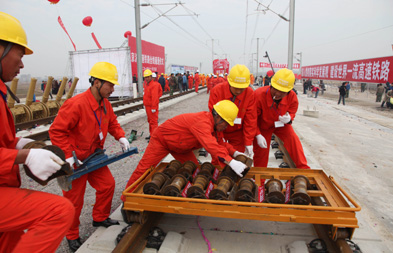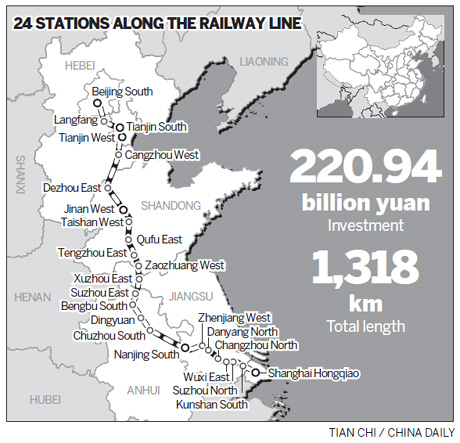China
Last track in place for high-speed train link
By Xin Dingding (China Daily)
Updated: 2010-11-16 07:56
 |
Large Medium Small |

Workers lay the last track for the Beijing-Shanghai high-speed railway in Bengbu, Anhui province, on Monday. Zhang Jianping / for China Daily

Journey between Shanghai and Beijing to be cut to four hours
BENGBU, Anhui -Track-laying work for the long-anticipated Beijing-Shanghai high-speed railway stood complete when Railways Minister Liu Zhijun tightened the line's last bolt on a windy Monday morning.
"The project has entered its last stage," Lu Chunfang, vice-minister of railways, said at a ceremony to celebrate the latest success in the city of Bengbu, situated in the center of the railway line.
Since the project kicked off on April 18, 2008, some 135,000 workers have toiled hard to lay 1,318 km of high-quality tracks.
In the next few months, workers will race against time to install the railway's power supply, communications and signal systems, and carry out operation trials to test the line and trains to ensure the railway can open to traffic next year, Wang Yongping, spokesman of the Ministry of Railways, said.
"The Beijing-Shanghai high-speed railway incorporates China's latest high-speed railway technologies," he said.
The 1,318-km railway costs 220.94 billion yuan ($33.29 billion) in total.
"The core factor that can tell a country's high-speed railway technology is the speed," said Guo Zhiyong, deputy chief engineer of China Railway Siyuan Survey and Design Group Co Ltd, which is in charge of the line's design.
"The future trial operations on this line are expected to beat the speed record of 416.6 km per hour achieved by the Shanghai-Hangzhou railway on Sept 28. And its future operation speed will also exceed that of the current 350 km per hour," he said.
The ministry aims to slash the travel time between China's two largest cities to only four hours, down from the current 10 hours.
Other technical highlights include engineers' innovations in tunnel design and construction that allow trains to encounter each other in the tunnel at a speed of 350 km per hour safely, and the world's first six-line high-speed railway bridge, the Dashengguan bridge in Nanjing, Jiangsu province, which spans 336 meters and allows trains to pass through at a speed of 300 km per hour.
The railway winds through seven provinces and municipalities along China's eastern coast, where one-fourth of the country's population lives, generating 40 percent of the country's GDP.
Along the way, there are 24 stops, including five major stations - Beijing South, Tianjin West, Jinan West, Nanjing South and Shanghai Hongqiao stations.
The new railway is expected to relieve the existing line of pressures from both passenger and cargo transport, said Wang Yongping.
For a long time, the railway department found it difficult to meet transportation demands along the line. Only 35 percent of the demand for cargo transportation could be met in the past, he said.
With the new rail line ready, the ministry estimates that it can ferry 80 million passengers in one direction annually. This will greatly enhance the railway transport capability between Beijing and Shanghai, as the existing railway will be used for cargo transport, he said.
China now leads the world with 7,431 km of high-speed railways in operation.
The country plans to build a high-speed railway network of 13,000 km by 2012. By then, passengers would be able to reach most provincial capital cities from Beijing in eight hours by train.
China Daily